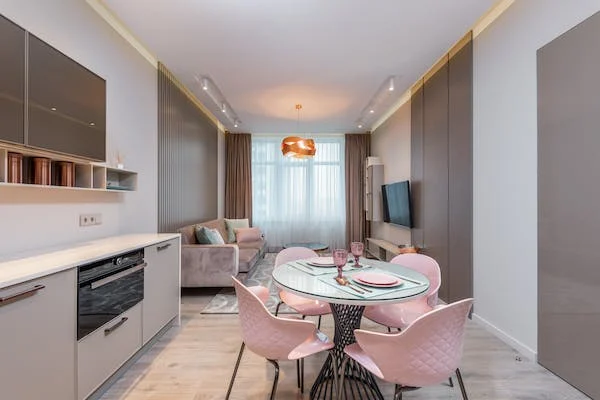Table of Contents
Natural Light: A Key Element in Modern Architecture
Today’s designers emphasize incorporating plentiful natural light in their architectural visions, owing to its power to energize and revitalize home environments. Not only is natural light an aesthetic enhancer, accentuating the design elements of a space, but it also serves a profound health function. Evidence suggests it can bolster wellbeing, with studies by The New York Times supporting the view that it can improve mood and enhance sleep quality. Illumination from the sun also reduces artificial lighting needs during the day, making it a boon for energy conservation. The intelligent manipulation of natural light through orientation, window design, and reflective materials reveals its potent ability to transform structures into vibrant, life-affirming spaces.
The Rise of Minimalism in Home Design
The essence of minimalism in the home design sector has been gathering traction for its ability to breathe a sense of calm and order into chaotic lifestyles. By stripping down to the essentials, minimalist design isn’t just about Spartan aesthetics; it’s an invitation to mindfulness and an appreciation for wonderfully crafted simplicity. High-quality and well-thought-out pieces take precedence, allowing each item’s functionality and beauty to imbue a space with tranquility. This approach is beautifully encapsulated by projects undertaken by reputable Seattle remodeling firms, setting a new standard for understated elegance. Therefore, minimalism isn’t about creating empty spaces but creating environments that resonate with personal solace and harmony.
Integrating Smart Technology into Home Design
The one revolutionary leap in contemporary home design is undoubtedly the infiltration of innovative technology. Home automation is rapidly becoming less of a luxury and more of a standard component of modern living. Whether for enhancing security, managing energy consumption, or improving everyday convenience, intelligent technologies are seamlessly woven into the fabric of domestic life. The latest advancements in this field are not only functional but are also being designed to complement the home’s aesthetic. With an upward trend in this digital integration, homeowners are empowered with unprecedented control and ease without compromising style and design.
Sustainable Materials Shaping the Future of Home Construction
The move towards sustainability is not just a global initiative but a personal one that extends into home building. Ecological awareness has galvanized a shift to sustainable materials in the construction industry. Biodegradable, renewable, and non-toxic options are taking center stage as modern homeowners seek to minimize their ecological footprint. This environmentally conscious approach has little to no downside, as these materials often come with the added benefits of durability and aesthetic versatility. Employing bamboo, cork, and reclaimed wood are just a few examples of how sustainability is finding a stable footing in contemporary construction and design.
Space-Saving Designs for Urban Living
With urban space at a premium, the creative use of space is fundamental in modern interior design. This growing challenge has sparked a wave of innovation, with designers conjuring versatile, space-saving solutions that don’t compromise style. As the age-old adage goes, necessity is the mother of invention—a principle that rings especially true in urban homes. Tight quarters can be transformed into multi-functional living quarters through the clever articulation of fold-down desks, wall beds, and nested furniture. These ingenuities aren’t just for necessity’s sake but are also an expression of modern living’s dynamic nature.
Outdoor Living Spaces and Their Growing Popularity
The yearning for a slice of the great outdoors without leaving the comfort of one’s home has led to a surge in the popularity of outdoor living spaces. These areas serve as personal sanctuaries where nature and architecture entwine. The rise of outdoor kitchens, fire pits, and weather-proof furniture has revolutionized the backyard concept, making it the new favorite room of the house for many individuals. Tailoring these spaces to reflect personal tastes and incorporating them into the overall design scheme of a home is becoming a common practice, further emphasizing the blurring of indoor-outdoor boundaries.
Design Techniques for Personal Wellbeing
Contemporary home design is increasingly driven by a holistic approach, placing a premium on the resident’s wellbeing. The psychological impact of a living environment cannot be overstated—from calming colors and natural elements to spatial configurations conducive to relaxation and introspection. By prioritizing comfort, serenity, and personal preferences, designers can craft spaces that look and feel good. This is not a mere aesthetic pursuit; it’s about empowering individuals to forge tangible connections with their living spaces—connections that nurture and restore.
The Future of Home Design Trends
As we gaze at the horizon of home design, it is evident that future trends will continue to evolve responsively with emerging technologies and societal changes. The burgeoning interest in adaptive, intelligent spaces that can change with our needs will likely give rise to a new era of personalized and efficient home design. The integration of augmented and virtual reality in design processes, coupled with advancements in eco-friendly materials and methods, suggests that the homes of tomorrow will be as bright as they are sustainable. It’s a future with creative potential and promises of living spaces attuned to individual and collective wellbeing.
Apart from that, if you are interested to know about How to Design a Home Space then visit our Home Improvement category.
















